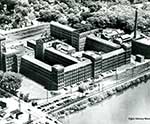Check out these unique destinations that reflect the genuine character of our region.
Eugene Debs Historical Marker
101 N. Johnson St., Woodstock, (815) 923-2267, mchenrycountyhistory.org
Eugene Debs, the leader of the American Railway Union, served a six-month term in the McHenry County Jail in 1895 after he refused to obey an injunction against the 1894 Pullman Strike. The strike paralyzed much of the nation’s rail systems and inspired a national Labor Day.
This past October, the Illinois State Historical Society and Woodstock Celebrates, a group of community activists, recognized the significance of Debs’ jailtime and its impact on the labor and free-speech movements by unveiling a plaque at the former jail site. It’s mounted on the side of the Old McHenry County Jail on Woodstock’s Historic Square.
“The Pullman case guided governmental response to strikes for nearly four decades,” the plaque reads.
After Debs was released from jail, he left Woodstock even more determined to fight for working people.
His time in the county jail turned him from a labor leader into a national political activist. He became a founder of the American Socialist party and its five-time presidential candidate. He also traveled the country defending workers in their strikes and union disputes.
In addition to commemorating Debs’ stay in prison, the historical marker honors the memory of Sheriff George Eckert, Debs’ jailer, who lived next door to the courthouse.
“Sheriff George Eckert protected Debs from threats and the Eckert family began three decades of warm friendship with Debs,” the plaque reads. “Eckert allowed Debs to use his jail time to study and ponder the plight of working-class Americans.”
Joseph F. Glidden Homestead and Historical Center
921 W. Lincoln Hwy., DeKalb, (815) 756-7904
Joseph Glidden’s invention in 1873 of what became one of the most widely used types of barbed wire changed the history of America and had a far-reaching impact throughout the world.
Glidden began searching for a better fence after his wife, Lucinda, complained about livestock getting into her yard. Aided by a coffee mill, Glidden created a fencing wire with sharp barbs.
The Glidden Homestead and Historical Center is dedicated to telling an American story of migration, innovation and philanthropy at the site where Glidden invented “The Winner” barbed wire.
For almost 20 years, Glidden lived in a log cabin he built on his 600-acre property after settling in DeKalb in 1842. In 1861, the Gliddens built a red brick home on the farmland.
When Glidden died in 1906, his nephew, John, took over the house and updated its electrical, plumbing, heating and architecture.
John’s daughter Jessie and her brother Carter were the last Gliddens to live in the house. After Carter died in 1998, Jessie moved out of the home. She was instrumental is getting the house listed on the National Register of Historic Places.
Glidden’s Homestead has been preserved and restored by a nonprofit organization founded in 1995. The museum is open year-round Tuesdays from 10 a.m.-2 p.m. It’s also open June through October on the second and fourth Sundays from noon to 4 p.m.
Elgin National Watch Historic District
Downtown Elgin, roughly from Villa Street to May Street, Wellington Avenue to Liberty Street
Just south of downtown Elgin, in an area occupied by a casino and cozy historical homes, is an area that’s closely associated with the Elgin National Watch Company. It was on 35 acres in this neighborhood that one of the world’s largest industrial businesses once sat.
From its founding in 1864 to its demise in the 1960s, Elgin National Watch manufactured millions of pocket and wrist watches, and it introduced more than half of the watches made in the country from 1920 to 1928. At its peak, the firm employed more than 4,300 people.
The watch company built an observatory in 1909 as a method of accurately keeping time and regulating the thousands of watches produced inside the factory. The observatory sat on the top of a hill just east of the watch factory.
Housing for watch factory workers was provided through land purchased by the company for the construction of cottages and National House, a boarding house for single workers. At its peak in 1919, that house contained 350 rooms. The structure was demolished in 1932.
By mid-century, atomic clocks had made astronomical timekeeping obsolete, so in 1959, the observatory was donated to Elgin’s U-46 school district.
The last Elgin watch produced in Illinois was made in 1964. The factory, with its giant clock tower, was razed in 1966.
Plenty of notable structures in the neighborhood still stand, including the Watch Factory Depot, the observatory, Fire Barn No. 5 and the Illinois National Guard Armory.




















































